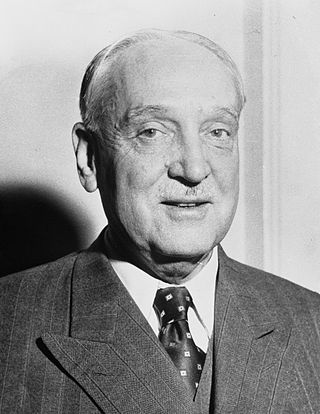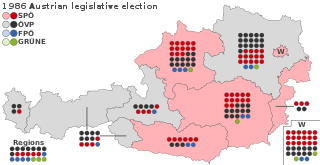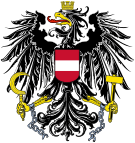
Politics in Austria reflects the dynamics of competition among multiple political parties, which led to the formation of a Conservative-Green coalition government for the first time in January 2020, following the snap elections of 29 September 2019, and the election of a former Green Party leader to the presidency in 2016.

Julius Raab was a conservative Austrian politician who served as Federal Chancellor of Austria from 1953 to 1961. Raab steered Allied-occupied Austria to independence, when he negotiated and signed the Austrian State Treaty in 1955. In internal politics Raab stood for a pragmatic "social partnership" and the "Grand coalition" of Austrian Conservatives and Social Democrats.

Bruno Kreisky was an Austrian social democratic politician who served as foreign minister from 1959 to 1966 and as chancellor from 1970 to 1983. Aged 72, he was the oldest chancellor after World War II.

The Communist Party of Austria is a communist party in Austria. Established in 1918 as the Communist Party of German-Austria (KPDÖ), it is one of the world's oldest communist parties. The KPÖ was banned between 1933 and 1945 under both the Austrofascist regime and the Nazi German administration of Austria after the 1938 Anschluss.

Leopold Figl was an Austrian politician of the Austrian People's Party and the first Federal Chancellor after World War II. He was also the youngest Federal Chancellor of Austria after the war before Sebastian Kurz.

The Ostmärkische Sturmscharen was a right-wing paramilitary group in Austria, founded on 7 December 1930. Recruited from the Katholische Jugend, later from journeymen and teacher organisations, it formed an opposition to both to the nationalist Heimwehr forces and the Social Democratic Republikanischer Schutzbund. The Christian Social politician Kurt Schuschnigg was its Reichsführer.

Adolf Schärf was an Austrian politician of the Socialist Party of Austria (SPÖ). He served as Vice-Chancellor from 1945 to 1957 and as President of Austria from 1957 until his death.

Early parliamentary elections were held in Austria on 23 November 1986. They were called by Chancellor Franz Vranitzky of the Socialist Party (SPÖ), as he was not prepared to continue the coalition government with new Freedom Party (FPÖ) leader Jörg Haider, who had ousted Norbert Steger at the party convention.

Parliamentary elections were held in Austria on 24 April 1983. The result was a victory for the Socialist Party, which won 90 of the 183 seats. However, the Socialists lost the outright majority they had held since 1971, prompting Bruno Kreisky to stand down as SPÖ leader and Chancellor in favour of Fred Sinowatz. The SPÖ stayed in office by entering into a coalition government with the Freedom Party of Austria, which at this point was a liberal party. Voter turnout was 93%.

Early parliamentary elections were held in Austria on 10 October 1971, following electoral reforms intended to benefit smaller parties. The number of seats in the National Council was increased from 165 to 183, and the proportionality of the seat distribution was increased as well.

Parliamentary elections were held in Austria on 1 March 1970. The Socialist Party (SPÖ) emerged as the largest party in the National Council, winning 81 of the 165 seats, just three seats short of an absolute majority and the first time it had become the largest party during the Second Republic. Voter turnout was 92%.

Parliamentary elections were held in Austria on 6 March 1966. The result was a victory for the Austrian People's Party (ÖVP), which won 85 of the 165 seats. Voter turnout was 94%.

Parliamentary elections were held in Austria on 10 May 1959. Although the Socialist Party (SPÖ) received the most votes, the Austrian People's Party won one more seat than the SPÖ. The Communist Party of Austria lost its remaining three seats and has not returned to the National Council since. Voter turnout was 94%. The grand coalition that had governed the country since 1945 remained in office, with People's Party leader Julius Raab as chancellor and Socialist leader Bruno Pittermann as vice-chancellor.

Parliamentary elections were held in Austria on 9 October 1949. About 500,000 registered Nazis, who were not allowed to vote in 1945, regained their voting rights. A newly created party, the Electoral Party of Independents (WdU) specifically targeted this group of voters and immediately won a large share of votes. The Austrian People's Party remained strongest party, although losing their absolute majority of seats. Leopold Figl stayed as Chancellor, leading a coalition with the Socialist Party of Austria as junior partner.

Parliamentary elections were held in Austria on 25 November 1945, the first after World War II. The elections were held according to the Austrian election law of 1929, with all citizens at least 21 years old eligible to vote, however former Nazis were banned from voting, official sources putting their numbers at around 200,000.

The Government of Austria is the executive cabinet of the Republic of Austria. It consists of the chancellor, who is the head of government, the vice chancellor and the ministers.

The Social Democratic Party of Austria is a social democratic political party in Austria. Founded in 1889 as the Social Democratic Workers' Party of Austria and later known as the Socialist Party of Austria from 1945 until 1991, the party is the oldest extant political party in Austria. Along with the Austrian People's Party (ÖVP), it is one of the country's two traditional major parties. It is positioned on the centre-left on the political spectrum.
Since its foundation in 1889, the Social Democratic Party has often been one of the main political forces in Austria. At the start of the First World War it was the strongest party in parliament, and on the ending of that war in 1918 the party leader Karl Renner became chancellor of the First Republic. The party lost power in 1920, but retained a strong base of support in the capital Vienna. A period of rising political violence culminated in the banning of the Social Democratic Party under the Austrofascist dictatorship (1934–38).
























